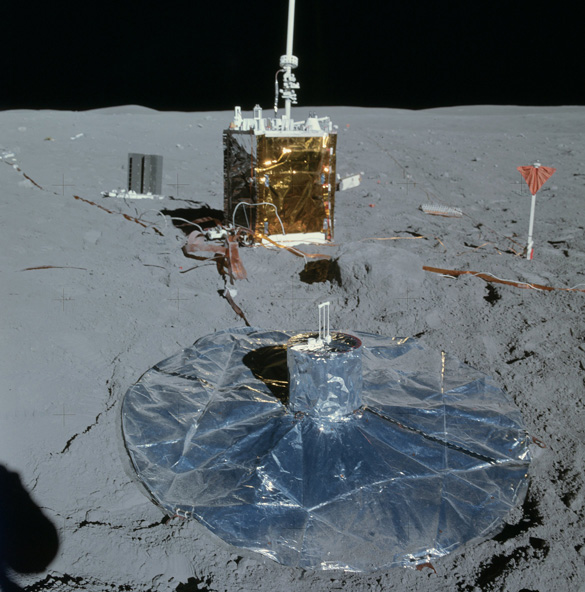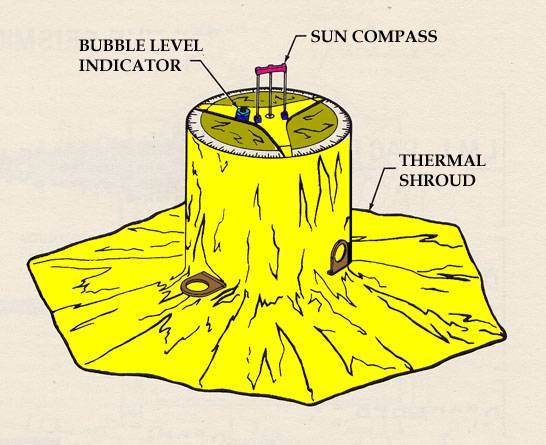
Apollo Guide
Apollo 11 Landing Site

Passive Seismic Experiment Package
The Passive Seismic Experiment studied the propagation of seismic waves through
the Moon and provided our most detailed look at the Moon's internal structure.
The Apollo 11 seismometer returned data for just three weeks but provided a
useful first look at lunar seismology. More advanced seismometers were deployed
at the Apollo 12, 14, 15, and 16 landing sites and transmitted data to Earth
until September 1977. Each of these seismometers measured all three components
of ground displacement (up-down, north-south, and east-west).
If a seismic event is observed by three or more seismometers separated by
distance, the time and location of the event can be determined. Because seismic
waves from distant events travel deeper into the Moon than waves from nearby
events, by measuring events at various distances from the seismometer, one can
determine how seismic velocities vary with depth in the Moon. In turn, this
information can be used to study the Moon's internal structure. Most of the
events observed by the seismometers were due either to moonquakes or to
meteoroid impacts. However, the third stages of several Saturn 5 rockets and the
ascent stages of several lunar modules were deliberately crashed onto the Moon
after they were discarded. These man-made crashes produced seismic events of
known times and locations and helped to calibrate the network of seismometers.
If a seismic event is observed by three or more seismometers separated by
distance, the time and location of the event can be determined. Because seismic
waves from distant events travel deeper into the Moon than waves from nearby
events, by measuring events at various distances from the seismometer, one can
determine how seismic velocities vary with depth in the Moon. In turn, this
information can be used to study the Moon's internal structure. Most of the
events observed by the seismometers were due either to moonquakes or to
meteoroid impacts. However, the third stages of several Saturn 5 rockets and the
ascent stages of several lunar modules were deliberately crashed onto the Moon
after they were discarded. These man-made crashes produced seismic events of
known times and locations and helped to calibrate the network of seismometers.
Non - Normal
Contingent EVA 2 - One Man , Two Hours
Description and Rationale
A second contingent EVA timeline is presented for a situation where only one crewman will egress .* The use of this EVA timeline , as for the other contingent timeline , will require a real time decision . All of the reasons , or even if one would be cons idered in real time , have not yet been determined . One reason might be the failure of one PLSS to check out . Another might be a LM subsystem malfunction which required continuous monitoring . Other suppos itions could require a decision to conduct a one man EVA.
As for Contingent EVA 1, it is assumed that the CDR can egress . However , if this is not possible , each crewman should be capable of accomplishing the other crewman 's tasks .
For this contingent situation the crewman on the surface should be able to accomplish most of the nominal activities within two hours . He may , however , require verbal assistance from the other crewman as well as more time to perform the tasks which he nominally does not perform.
* The Final Flight Mission Rules for Apollo 11 will govern the selection of the crewman to egress and the EVA he will accomplish.






|
|
|
Home / Acronyms / Index / Schematics / Systems
Operations / Non-Normal / Normal
Panels / 1 / 2 / 3 / 4 / 5 / 6 / 8 / 12 /14
Copyright 2021 APOLLO 11 GUIDE©